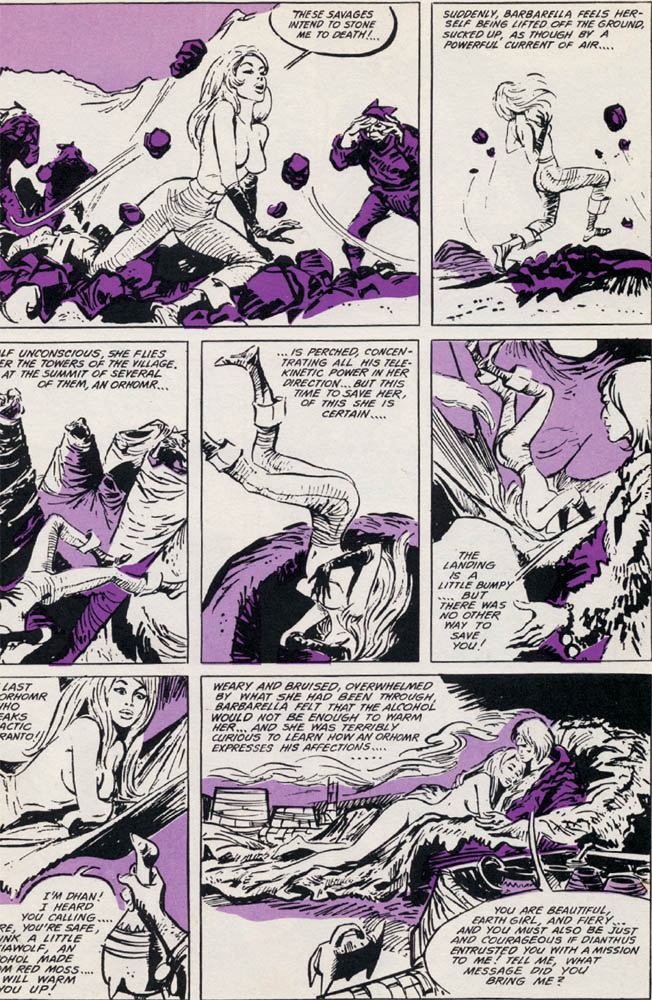
As the permissive society exploded in 1960s France, one comic creator who truly caught the Zeitgeist was Jean-Claude Forest. Born in the Parisian suburb of Perreux in 1930, Forest studied at the Paris School of Design, worked as an illustrator in the early ’50s, and became the premier paperback cover artist of the French science-fiction imprint, Le Rayon Fantastique. But it was when he created the character of Barbarella in 1962 that Forest became world-famous.
“George Gallet, the editor of Le Rayon Fantastique, was also in charge of a quarterly adult publication called V Magazine,” recalled Forest in the ’80s. “One day, he asked me if I wanted to do a strip for him—no holds barred! Twenty years ago, we were living in a time of complete censorship in comics… That’s why I was doing mostly illustrations and book covers. Everything was forbidden, especially the female form. Fantasy was also frowned upon, because it was felt that it would corrupt the morals of children. Gallet asked me to do a kind of female Tarzan—‘Tarzella’—but that idea didn’t interest me. It did lead me to come up with Barbarella though, and for the next two years, at the rate of eight pages every three months I told her adventures, going with the flow of inspiration without any preplanning.”
Barbarella told the sexploitational space saga of a young heroine crash-landing on planet Lythion. She becomes involved in a war between the Crystallians, who inhabit a giant greenhouse, and the barbaric Orhomrs, who live in the frozen wasteland outside. With a little bit of love, she persuades them to call a truce. In 1964, two years after Barbarella’s first appearance in V Magazine, Eric Losfeld published a collection. Despite the censor’s ruling that the book could not be publicly displayed, it sold over 200,000 copies and was translated across the world.
Dubbed, inaccurately, the “first comic strip for grownups,” Barbarella attracted rave reviews from a varied assortment of magazines. The French literary weekly, Arts, called it “a modern epic” while Newsweek lauded the space vixen as “a mythic creature of the space age” and Playboy agreed it was “the very ‘apoptheosis’ of eroticism.” After that, the sexy space woman’s adventures took her on a whole gamut of sexcapades throughout the known universe, encountering pirates living inside a giant jellyfish, a gang of children who employ carnivorous dolls, and a handsome, blind angel.
Dino De Laurentis quickly bought the film rights and offered the role to Jane Fonda, who promptly threw the script in the trash. Her then-husband, director Roger Vadim, persuaded her something original and exciting could be done with the subject. Forest worked for eight months on the picture, which was released in 1968.
After Barbarella, Forest developed a sequel, Les Coleres du Mange-Minutes (The Wrath of the Minute-Eater). Not wanting to be typecast as an erotic artist, he emphasized the science-fiction and poetry. This resulted in “a terrible disaster!” Forest exclaimed. “I didn’t want to go deeper into eroticism, I wanted to manifest my freedom. Besides, I’m against pornography. My intention was to remove Barbarella from her public image.” After the commercial failure of Minute-Eater, Forest’s career hit a slump. “For two years, I couldn’t find any work,” he recalled. “I was considered a distinguished erotomaniac by the comics industry! They wanted to give me things to do, but they were afraid of my reputation. They thought, ‘If it’s Forest, there will be sex in it and we’ll be in trouble!’”
Forest then did a loose space adaptation of Jules Verne’s Mysterious Island, called Mysterieuse Matin, Midi et Soir (Mysterious Morning, Noon, and Evening). The Mysterieuse characters reappeared in Forest’s series The Adventures of Hypocrite, the artist’s appropriately named return to erotic themes. Barbarella then appeared in Le Semble Lune (The Moon Child), where she explored a dream dimension and finally gets married and has a baby, Little Fox. This was the last Barbarella story Forest drew before handing the art chores to Daniel Billon. In 1981, Forest wrote a final episode of Barbarella, for L’Écho des Savanes.
Forest also wrote for a number of France’s comic artists, including Jacques Tardi and Paul Gillon—whose own erotic sci-fi comics paid homage to Forest.
Forest received the Angouleme Comics Festival’s 1984 Grand Prize and the “Magician of Comics” was even given his own French postage stamp in 1989. Forest passed away on December 29, 1998, aged just 68, but his sultry space siren lives on in Robert Rodriguez’s 2009 remake of the movie.
Jean Claude Forest’s classic creation Barbarella depicted a sexually liberated woman, reflecting the social mores of the 1960s. Barbarella would use her body to disarm enemies and to enjoy robotic lovers.